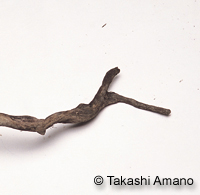
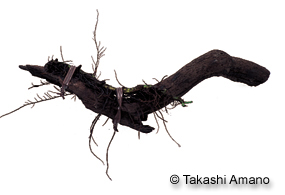
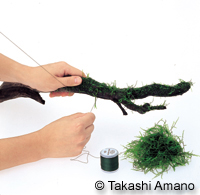
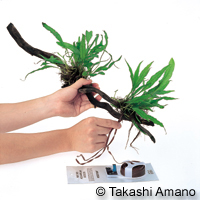
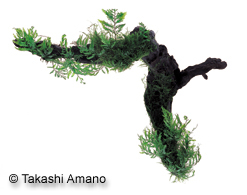 Q1.
Do you have a tip for attaching ferns and willow moss to driftwood?
Q1.
Do you have a tip for attaching ferns and willow moss to driftwood?
A1. Mosses and ferns often grow on driftwood in nature such as those you see in mountain streams. I sense a long passage of time and the feeling of "Wabi and Sabi"1 in their appearance. In the Nature Aquarium, Bolbitis, Microsorum and willow moss are often grown attached to driftwood to create such natural atmosphere in an aquascape.
As for the order to attach these aquatic plants, I first arrange driftwood in an aquarium, and then decide on the places to attach aquatic plants. If willow moss is going to be attached over the entire driftwood, you can attach it to the driftwood with Moss Cotton ahead of time. If it were to be attached only on parts of driftwood, the driftwood should be arranged in the aquarium first and the places to attach willow moss should be decided by looking at the overall balance.
As for the places to attach aquatic plants, I often attach them in the key points of an aquascape such as a tip of driftwood and where their branches are crossed, and depending on the driftwood, over unnatural looking spots such as an artificial cut end.
Once I know where to attach them, I spread willow moss thinly and secure it by wrapping Moss Cotton over it. An important point for attaching a member of the fern family is to cut off old leaves of ferns, such as Bolbitis and Microsorum, as much as possible before attaching them to driftwood. Old mature leaves do not easily adapt to a new environment and algae tend to grow on them. The tip of a young growing leaf of Microsorum is transparent. You should keep mainly these young leaves and cut off old ones. In the case of Bolbitis, you can cut off most of the large leaves. In an extreme case it is quite fine to attach only the rhizomes to driftwood. Doing so allows the ferns to develop clean new leaves that are adapted to the new aquarium environment.




Q2. What should I look for when I select driftwood?
A2. When you buy driftwood, you often select from a number of pieces. The most important thing at this point is the size. If you are using a pendant type lighting fixture, it is not a problem if driftwood sticks out from the water surface. However, for a standard aquatic plant layout, it is inconvenient if the driftwood cannot fit inside an aquarium. The next important thing is the number of driftwood pieces and the balance. Since multiple driftwood branches are used together, it is important to choose them for the balance of the assembled form. If too many driftwood pieces are used, there will be not enough space to plant aquatic plants. However the thing you need to pay closest attention to when choosing driftwood is the shape of the tip. Some driftwood pieces are artificially cut on one end. If you choose driftwood with a naturally looking narrow end, it can bring out a natural feeling in an aquascape by itself.

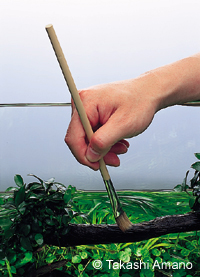
Q3. What do we do if algae start to grow on driftwood?
A3. I often use branchy driftwood such as Old Black Wood without attaching aquatic plants on them, exposing their surface in order to take advantage of their texture and line. When used this way, the lines of dark driftwood tighten up an aquascape and clearly define the composition. However, some attention is required since algae tend to grow better on a bare surface of driftwood than on aquatic plants. Although putting herbivores into an aquarium is an effective way to deal with algae, Yamato Numa Ebi and Otocinclus are not effective for some type of algae. The green algae that lightly covers the entire surface of driftwood and black beard algae tends to grow on a bare surface of driftwood. For this type of algae, Siamese Flying Fox (Crossocheilus siamensis) and Parotocinclus maculicauda are effective. If algae growth is significant, you can drain the water from your aquarium and apply Phyton-Git with a brush directly on the driftwood exposed to air.
*1 The concept of Wabi Sabi: The concept represents the traditional Japanese view of the world and sense of beauty deeply rooted in Zen Buddhism. It is a beauty of things imperfect, impermanent and incomplete. It also applies to the beauty of things modest and humble.